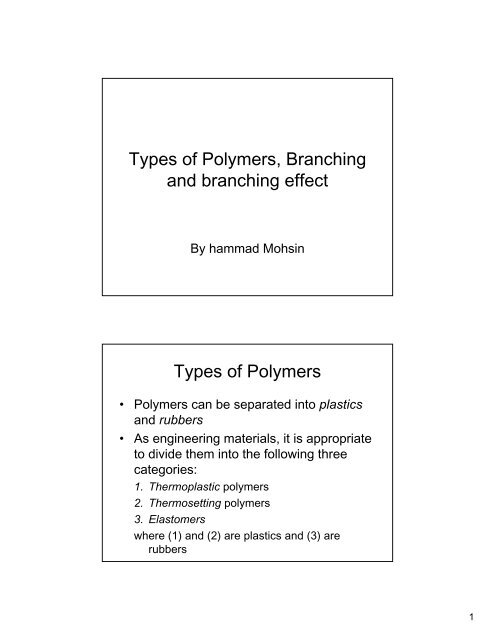Types of Polymers, Branching and branching effect Types of Polymers
Types of Polymers, Branching and branching effect Types of Polymers
Types of Polymers, Branching and branching effect Types of Polymers
You also want an ePaper? Increase the reach of your titles
YUMPU automatically turns print PDFs into web optimized ePapers that Google loves.
<strong>Types</strong> <strong>of</strong> <strong>Polymers</strong>, <strong>Branching</strong><strong>and</strong> <strong>branching</strong> <strong>effect</strong>By hammad Mohsin<strong>Types</strong> <strong>of</strong> <strong>Polymers</strong>• <strong>Polymers</strong> can be separated into plastics<strong>and</strong> rubbers• As engineering materials, it is appropriateto divide them into the following threecategories:1. Thermoplastic polymers2. Thermosetting polymers3. Elastomerswhere (1) <strong>and</strong> (2) are plastics <strong>and</strong> (3) arerubbers1
Thermoplastic <strong>Polymers</strong> -Thermoplastics (TP)• Solid materials at room temperature butviscous liquids when heated totemperatures <strong>of</strong> only a few hundreddegrees• This characteristic allows them to be easily<strong>and</strong> economically shaped into products• They can be subjected to heating <strong>and</strong>cooling cycles repeatedly withoutsignificant degradationThermosetting <strong>Polymers</strong> -Thermosets (TS)• Cannot tolerate repeated heating cyclesas thermoplastics can– When initially heated, they s<strong>of</strong>ten <strong>and</strong> flow formolding– But elevated temperatures also produce achemical reaction that hardens the materialinto an infusible solid– If reheated, thermosets degrade <strong>and</strong> charrather than s<strong>of</strong>ten2
Elastomers<strong>Polymers</strong> that exhibit extreme elasticextensibility when subjected to relativelylow mechanical stress• Also known as rubber• Some elastomers can be stretched by afactor <strong>of</strong> 10 <strong>and</strong> yet completely recover totheir original shape• Although their properties are quite differentfrom thermosets, they share a similarmolecular structure that is different fromthe thermoplasticsExamples <strong>of</strong> <strong>Polymers</strong>• Thermoplastics:– Polyethylene, polyvinylchloride,polypropylene, polystyrene, <strong>and</strong> nylon• Thermosets:– Phenolics, epoxies, <strong>and</strong> certain polyesters• Elastomers:– Natural rubber (vulcanized)– Synthetic rubbers, which exceed thetonnage <strong>of</strong> natural rubber3
Linear, Branched, <strong>and</strong> Crosslinked<strong>Polymers</strong>• Linear structure – chain-like structure• Branched structure – chain-like but withside branches• Cross-linked structure– Loosely cross-linked,– Tightly cross-linked,Source: R. Esf<strong>and</strong>, , D.A. Tomalia, , A.E. Beezer, , J.C. Mitchell, M. Hardy, C. Orford,Polymer Preprints, 41 (2), 1324 (2000)4
Linear structure <strong>of</strong> a thermoplasticpolymerFigure 8.7 - Various structures <strong>of</strong> polymer molecules:(a) linear, characteristic <strong>of</strong> thermoplasticsBranched structure that includes sidebranches along the chainFigure 8.7 - Various structures <strong>of</strong> polymer molecules: (b) branched5
Effect <strong>of</strong> <strong>Branching</strong> onProperties• Thermoplastic polymers always possesslinear or branched structures, or a mixture<strong>of</strong> the two• Branches increase entanglement amongthe molecules, which makes the polymer:– Stronger in the solid state– More viscous at a given temperature in theplastic or liquid state7

















